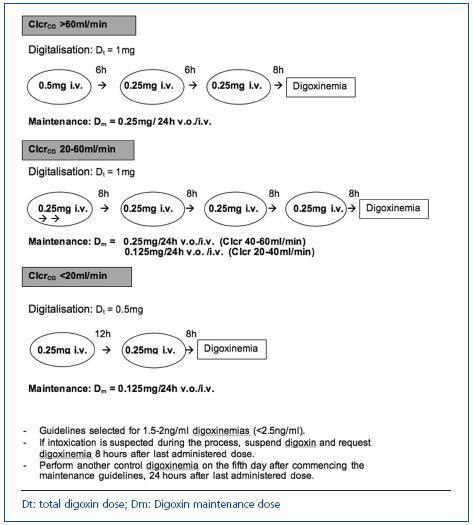To the Editor,
In a “Letter to the Editor” recently published by Suarez et al,1 a case of digitalis poisoning is described in an 82-year-old woman, with a history of heart failure and chronic renal failure (CRF). The patient attended the emergency department with signs of confusion, observing a nodal rhythm of 34 beats/min and blood pH level of 7.29, potassium 6.8mEq/l, creatinine 4.8mg/dl and digoxinemia 5.4ng/ml. She was treated with intravenous hydration and haemodialysis, with good results. After reading the letter, we would like to present a series of observations.
Given the significance of CRF as a main cause of digitalis poisoning in elderly patients, the importance of individualised dosage of digoxin according to kidney function should be emphasised. We have proposed a theoretical rapid digitalisation nomogram and maintenance doses of digoxin according to the Cockroft-Gault (ClcrCG) glomerular filtration index (figure 1),2-4 in accordance with the information obtained in bibliographic searches regarding recommendations for adjusting digoxin dosage in CRF and supported by our practical clinical experience. If we apply this to the case presented, the recommended maintenance dose would have been 0.125mg daily (½ tablet), adjusted to the moderate CRF that the patient presented (ClCrCG of approximately 40ml/min).
Furthermore, we would like to insist on the importance of pharmacological interactions of digoxin as a potential risk factor of digitalis poisoning. This point is especially relevant in polymedicated patients. Along with the mentioned verapamil and amiodarone, we should add other calcium antagonists such as diltiazem and diuretics such as spironolactone, due to their frequent simultaneous use in heart disease patients. In addition, given the high incidence of infection in the elderly, the interaction between digoxin and a variety of antibiotics, in particular macrolides, such as erythromycin and clarithromycin and tetracyclines, should be kept in mind.5
In their "Letter", the authors mention hyperkalaemia as a predictive risk factor concerning the severity of digitalis poisoning. It should be clarified that hyperkalaemia has been described as a marker with poor prognosis only in acute digitalis poisoning and is not useful as a prognostic factor in chronic poisoning, as seems to be the case of the “Letter”.6
As mentioned in the text, the presence of sinus bradycardia or advanced blockage that do not respond to pharmacology and with a haemodynamic deterioration would be due to the use of a pacemaker. The risk of electro-catheter (internal pacemaker) placement should be mentioned for patients with digitalis poisoning given the myocardial irritability induced by the drug, where anti-digoxin antibodies could be used as a alternative therapy.7
The “Discussion” refers to stomach pumping as a therapeutic option in digitalis poisoning. It should be pointed out that digestive decontamination is only effective in patients with acute oral digitalis poisoning (accidental intake or suicide attempt), and provided that no more than two hours have passed since its consumption. In the event of the patient being conscious, oral administration of activated charcoal should be considered as the best therapeutic option.
Meanwhile, the authors mention a rebound effect with differed increase of digoxinaemia after an initial administration of anti-digital antibodies in CRF patients. In reference to this, we would like to point out that this effect can occur in all patients, since it is due to the pharmacokinetic behaviour of digoxin and not to an alteration in kidney function.8 After administering the anti-digital antibodies, in 1-2 minutes, the free digoxin in the blood is quickly reduced to values close to zero, due to the formation of anti-digital digoxin-antibody complexes, which creates a concentration gradient that promotes mobilisation of tissue digoxin to the blood where it is newly activated by the formation of antibody complexes which are still free. This mobilisation involves an increase in the total digoxin in blood and represents an index of efficacy of the antibodies.8,9
Lastly, it should be added that the evaluation of the severity of intoxication cannot only consider digoxinaemia, given the frequent discrepancy between plasma concentrations of the drug and the cardiovascular repercussions. To calibrate the importance of the poisoning, it is necessary to have data regarding kidney function, plasma ion concentration, ECG, haemodynamic evaluation and systemic repercussions.
Figure 1. Proposed rapid digitalisation nomogram in the control of auricular fibrillation and digoxin maintenance dose according to the patient¿s ClcrCG







